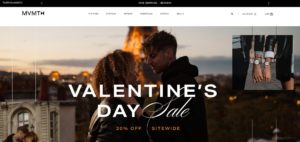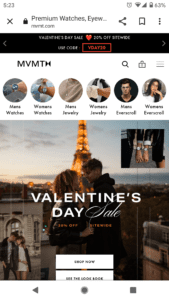70% of bridal retailer Azazie’s customers are millennials, with the “sweet spot” of its shoppers in the 25 to 34 age group, says chief marketing officer Ranu Coleman.
And that young cohort of shoppers means Azazie’s web traffic and sales skew heavily toward mobile devices: 73% of Azazie’s 2021 web traffic were from smartphones, and 60% of its sales were from smartphones, which includes mobile web and its app, Coleman says.
“It’s grown incrementally every year,” Coleman says about mobile sales. “Our customer base being on their phone 24/7 is probably part of it. It keeps happening every year as our demo gets younger and younger.”
And young shoppers like smartphone shopping for the immediacy it offers, Coleman says.
“The younger customer wants that immediate gratification. Our shoppers tend to be very savvy and they want everything right now,” Coleman says.
Over the last few years, many retailers have also experienced the same incremental shift to more and more mobile traffic and sales. For example, during the 2021 holiday season, 43% of online sales were from smartphones, up from 40% in 2020, according to Adobe Analytics data for November and December. Data from the Digital Commerce 360 Top 1000 back this up, especially for retailers with a younger shopping cohort. For the Top 1000 North American-based online retailers, the median share of traffic to a Top 1000 retailer’s site from mobile was 65.0%, up from 62.1% in 2020 and 58.2% in 2019.
Within the Top 1000, roughly 230 retailers have younger shoppers, with more than 50% of their web traffic coming from shoppers ages 35 and younger. (The exact number of retailers varies each year based on which retailers make the Top 1000.) For these younger-focused merchants, mobile traffic is even higher. Among the 230 retailers, the median share of mobile traffic was 68.4% in 2021, 65.3% in 2020 and 60.7% in 2019.
Three online retailers with a younger shopper base—watch and accessories brand MVMT (owned by Movado Group Inc.), apparel brand True Religion Brand Jeans and Azazie—share how they cater their mobile shopping experience to younger shoppers with mobile-focused design, offering pay-in-installment buttons and providing apps with unique features.
More mobile traffic means design must be mobile-first
Retailers have broken down barriers to mobile shopping, says Spencer Stumbaugh, chief brand officer at MVMT. This was not the case just a few years ago when mobile commerce was all about getting consumer awareness and traffic, but conversion happened on the desktop. That’s all changed, for both MVMT and the overall market, Stumbaugh says.
In 2018, desktop traffic was roughly 75% of MVMT.com’s traffic, mobile 25%. Just three years later in 2021, smartphones accounted for a whopping 85% of its overall traffic. And its mobile sales and conversion have also increased at MVMT.
“Our conversion rate is higher on desktop, but they are going there with more intent,” Stumbaugh says. without revealing more. “Over the past few years, our conversion rate has skyrocketed on mobile.”
Within the Top 1000, the median share of mobile web sales in 2020 was 51.6% and jumps higher for retailers with 50% or more of their traffic from consumers ages 35 and younger, with a median of 55.5% share of mobile sales in 2020.
MVMT’s core customer demographic is millennials, he says. As this cohort of shoppers quickly adopted conducting their lives on smartphones—from sending emails, engaging on social media to shopping—MVMT knew it needed to invest in its mobile experience to keep up with its target audience.
MVMT had always had a responsive website—meaning the site code would automatically format to the width of the browser no matter if it the shopper was browsing on a desktop or smartphone—but in 2016, it invested in mobile-specific design templates. MVMT first would come up with a design for a smartphone screen and then think about how it would scale to the larger version to view on a desktop, Stumbaugh says.
“When developing a new blog page or if we are updating product pages, we mock those up. Here’s the wire frame, and all the information we want to convey, and we’ll design it mobile-first, and then how it unstacks to desktop.” Stumbaugh says. “It’s a mobile-first process the vast majority of the time.”
Still, shopping on mobile is not perfect as a third of consumers cite at least one issue with purchasing on a smartphone, according to a Digital Commerce 360/Bizrate Insights survey of 1,088 online shoppers in January 2022.
This is why MVMT continually iterates on its mobile design, Stumbaugh says. MVMT will re-test certain features every one to two years to ensure they are still resonating with consumers. For example, on its product landing page for shoppers clicking through from an Instagram ad, MVMT has changed several times where it locates its “add to cart button.”
At first, it was near the top of the page, under the product detail pages. But as consumers scrolled throughout the page, they would have to scroll up to add it to their cart. MVMT changed to have the “add to cart” stick to the bottom of the page even as consumers scrolled down. It then realized that shoppers were becoming blind to the button because it was always there and would often scroll around the page a few times before locating it. Now, MVMT has the button near the top of the page and stuck to the bottom.
MVMT typically has three tests deployed at once, and it looks for a 5-25% increase in conversion, Stumbaugh says.
“You’re not going to see a 50% increase, but we have had things—simple things—as big as 25%,” he says. For example, MVMT’s conversion rate increased 24% for certain eyewear products when it changed the main image from a front view to show the product at an angled side view.
In general, for its mobile design, MVMT works to have the shopper experience “streamlined” so consumers can make a buying decision fast, Stumbaugh says.
“The goal with the mobile site is to make it easy to consume all the information to make a purchase, make it as streamlined and as quick as possible,” he says.
That means MVMT has call-to-actions, such as “shop now” before the consumer must scroll, and it chooses images that format well on mobile, such as an image with a portrait orientation rather than a landscape one, he says.
Also, on its mobile site, MVMT displays its top-navigation product category items, such as “men’s watches” or “women’s jewelry,” in circles at the top of the page. This is similar to how the “stories” feature looks on Instagram to make the mobile design look more familiar to its young shoppers, Stumbaugh says. MVMT knows its shoppers are on Instagram and it wants to convey that it is also part of the social media era.
“We want you to feel at home,” he says.

On desktop (above), the product navigation shows words with no images. On mobile, MVMT’s product navigation is in circles that resemble the “Stories” feature on Instagram.

It also ensures that it showcases as many payment providers to make it easier–such as PayPal, pay-in-installments Klarna and Apple Pay. MVMT detects the type of browser the shopper is on and shows the Apple Pay button first if the shopper is on an iPhone or Google Pay if on Android.
Pay-in-installment fast buttons cater to young, mobile shoppers
Buy now, pay later buttons like Klarna have recently surged in popularity and cater to mobile and young shoppers. Within Digital Commerce 360’s Top 1000, 29.2% of retailers offer a buy now, pay later service. That penetration skyrockets for mobile-focused retailers. For merchants with more than 50% of their sales from mobile, 60.7% of them offer buy now pay later. For merchants with 50% or more of their traffic from consumers ages 35 and younger, 31.0% offer buy now, pay later.
Pay-in-installments is attractive to True Religion in its goal to acquire more Gen Z shoppers, says Angela Clark, executive vice president of digital. These young shoppers don’t necessarily use credit cards, so pay-in-installments are an attractive option for a product that costs $149-$200.
True Religion’s shoppers are also mobile-savvy. About 80% of TrueReligion.com’s sales and 90% of its traffic are from mobile devices, Clark says.
In Q1 of 2022, True Religion added buy now, pay later payment Klarna to its checkout experience.
The brand already had AfterPay Ltd., which functions similarly to Klarna in that it lets shoppers break up a purchase into several payments and pay over several months. But, Afterpay caters to a millennial and older customer base, and Klarna has five-time as many users as Afterpay, many of whom are Generation Z, Clark says.
Putting value into an app
Another way True Religion is planning to cater to its young, mobile audience is by launching a shopping app in 2022. The brand had an app before—roughly five years ago—however, it was primarily a mirror of its mobile site and ultimately not a success, Clark says. This time, True Religion plans to make the app have unique, app-only features and exclusive products to give a reason for consumers to download and then stay in the app, she says.
“The benefit of having a web app is that you can do a lot more cool, fun things,” Clark says.
For example, True Religion will integrate functionality that shoppers are used to in social media apps, such as swiping left or right to like a product and integrating videos similar to Instagram stories or TikTok videos. The app will also have exclusive products, first-release of some products and better loyalty offers.

Angela Clark, executive vice president of digital, True Religion
These features are in hopes of creating an engaging app for consumers, who will, in turn, have a high conversion rate and higher lifetime value, Clark says.
This is the way to go, says, MVMT’s Stumbaugh says, as retailers need to give consumers a reason to download their app.
“You got to be a large retailer if you are taking up app space on my phone. You really got to add a lot of value,” Stumbaugh says.
While Stumbaugh sees the value of apps for a certain type of retailer it wouldn’t make sense at the moment for MVMT, because the merchant doesn’t have a huge assortment of products, and watches aren’t a high-frequency purchase like a mass merchant or apparel brand, he says.
“Once you hit that scale, apps can make a lot of sense and value,” he says.
For Azazie, its bridal shoppers typically are shopping for just one dress. But, it launched its app in 2016 as a way for a bride to have a more personalized shopping experience and get feedback from her bridal party. Within the app, she can browse all of Azazie’s dresses, create a list of her favorites and share the dresses with her family and friends. Within the app, the bride’s friends can leave comments.
“While fast fashion apps are designed around loyalty and driving sales, our is more creating a community experience with the entire bridal party through your app and your device,” Coleman says.
In the U.S., consumers spent 2.97 billion hours in retail apps in 2021, up 12% from 2.65 billion hours in 2020 and 2.02 billion hours in 2019, according to app measurement firm App Annie.
Retailers that decide an app is right for their business need to weigh the costs. At True Religion, Clark expects the app will drive $6 million in sales within the first year, $4 million of which will be incremental. Clark expects that the app will cannibalize about $2 million in sales from shoppers who would have made these purchases in a different channel, such as the mobile website. But the hope is the incremental revenue will come from new customers and increasing the frequency of purchases from already loyal shoppers with the new, engaging platform. These are conservative goals, she adds.
True Religion started building the app in-house in December, with the goal of launching by June 2022 at the latest. The design is planned and the marketing plan is in progress. Next is building the functionality, Clark says.
At least six employees are working on the app—including three from the ecommerce team and three from the IT team. Not including those employees’ time and salaries, the app will cost an additional $200,000 to build, she says.
“It’s not inexpensive,” Clark says. “The long-term ROI on it is strong and it’s definitely worth it,” she adds.
Young shoppers are more mobile-focused because of how millennials and younger generations use their phones, says Mark Williams, CEO of financial service provider Brokers International Ltd. This generation is used to doing much of their communication online, often via chat and social media, and not by actually talking on that phone. This means that retailers need to offer everything in a mobile format, including their design, marketing, payment and promotions and customer service.
Favorite